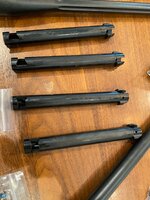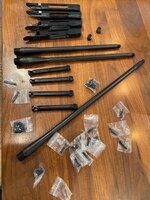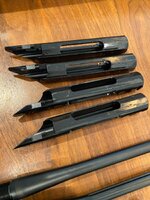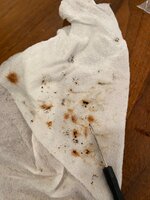Yes I believe they are all some type of 416 stainless. Could be the difference between the stainless/chrome moly lug abutments in the action supporting the lugs but I’m just guessing. I have no worries if I ever send in any of my tikkas in for nitriding since they are all CM. Might give h&m a call later to have a discussion with them on the subject.
Navigation
Install the app
How to install the app on iOS
Follow along with the video below to see how to install our site as a web app on your home screen.
Note: This feature may not be available in some browsers.
More options
Style variation
You are using an out of date browser. It may not display this or other websites correctly.
You should upgrade or use an alternative browser.
You should upgrade or use an alternative browser.
Tikka Nitriding
- Thread starter wind gypsy
- Start date
Okay spoke with an h&m rep. First I asked about cerakote. He said they will blast it off for free but you have to make a specific note for them to do so. Then asked him specifically about tikka actions CM&SS. He said there is no issue with either but to place cm&SS parts in separate bags and label them. I then asked if they needed to know the exact type of stainless they were working with to treat it properly. He stated the process for stainless is pretty much the same for all stainless types but it does change somewhat for different types of CM steels. I asked if he knew what type of CM steel blued tikkas were made of? He said no and acted like that would be a question for one of the shop guys. In the end he said the more specific info you can give them about the specific steels you’re sending in the better they can identify how to nitride them. The guys in the shop probably already know all this stuff but now it has me wanting to contact beretta/tikka to see if I can get the exact metallurgy of the steels used in tikkas. He also stated with the stainless bolt and cm action it may wear more as when the stainless is nitrided it’s harder than the nitrided cm. Although I’m sure wear through cycling the action is near to nothing even over thousands of rounds. Teeth or parts on a rock saw or something yea there will be significant wear over time.
Sundodger
WKR
I can’t imagine Tikka/Beretta would ever tell us the metallurgy, I know no where I have worked would give out such info.Okay spoke with an h&m rep. First I asked about cerakote. He said they will blast it off for free but you have to make a specific note for them to do so. Then asked him specifically about tikka actions CM&SS. He said there is no issue with either but to place cm&SS parts in separate bags and label them. I then asked if they needed to know the exact type of stainless they were working with to treat it properly. He stated the process for stainless is pretty much the same for all stainless types but it does change somewhat for different types of CM steels. I asked if he knew what type of CM steel blued tikkas were made of? He said no and acted like that would be a question for one of the shop guys. In the end he said the more specific info you can give them about the specific steels you’re sending in the better they can identify how to nitride them. The guys in the shop probably already know all this stuff but now it has me wanting to contact beretta/tikka to see if I can get the exact metallurgy of the steels used in tikkas. He also stated with the stainless bolt and cm action it may wear more as when the stainless is nitrided it’s harder than the nitrided cm. Although I’m sure wear through cycling the action is near to nothing even over thousands of rounds. Teeth or parts on a rock saw or something yea there will be significant wear over time.
If you really are curious, you could send some OEM parts out to a lab and have hardness, grain structure, and chemical composition checked. That would get you the alloy and give you a pretty good idea of any heat treatment they do… but they could change their process at anytime and you wouldn’t know.
Yea I’d probably have better luck winning the lottery than getting a response from beretta.
Really don’t want to tear up one of my actions. But maybe I can get hired on as a janitor at UM and sweep up some of those mill cuttings from the lightening cuts.
As much as I’d I like to know the fine details of tikkas metallurgy. If I do decide to nitride one Il probably just send it in and not worry about. But for the hell of it I’m going to send out a few emails inquiring, just to see if I can get a response.
Really don’t want to tear up one of my actions. But maybe I can get hired on as a janitor at UM and sweep up some of those mill cuttings from the lightening cuts.
As much as I’d I like to know the fine details of tikkas metallurgy. If I do decide to nitride one Il probably just send it in and not worry about. But for the hell of it I’m going to send out a few emails inquiring, just to see if I can get a response.
Coopsdaddy
WKR
So if you build a tikka and want it nitrided would you use a blued or stainless or does it really matter.
Would you do the barrel or stick with cerakote on it.
Who does UM use for nitriding?
Would you do the barrel or stick with cerakote on it.
Who does UM use for nitriding?
Our process is to buy blued rifles and nitride the action and barrel (after threading) but DLC the bolt instead of nitriding it. We use H&M West for the nitride and DNA for the DLC. Not sure who UM uses but good chance it’s also H&M.So if you build a tikka and want it nitrided would you use a blued or stainless or does it really matter.
Would you do the barrel or stick with cerakote on it.
Who does UM use for nitriding?
-J
Coopsdaddy
WKR
Don’t see any reason to pay 200 more for a stainless if there getting nitrited anyway.
Thanks
Thanks
BBob
WKR
I can’t imagine Tikka/Beretta would ever tell us the metallurgy
Take your clean bare metal action to one of your local recyclers that has a PMI/XRF gun and get the results. Some will do it for free, some a small charge. Once you have the results you can compare them to common alloys and see what fits. We have a local that does it for us to help ID parts we need to duplicate.As much as I’d I like to know the fine details of tikkas metallurgy.
Sundodger
WKR
Take your clean bare metal action to one of your local recyclers that has a PMI/XRF gun and get the results. Some will do it for free, some a small charge. Once you have the results you can compare them to common alloys and see what fits. We have a local that does it for us to help ID parts we need to duplicate.
Chemical composition is just one piece of the pie. You need to analyze grain structure and test hardness to be able to make an educated guess on heat treatment and such.
BBob
WKR
Hardness is readily identifiable with a hardness tester. I have a Wilson. Most actions aren’t very hard and the hardening isn’t anything special with the typical alloys used. Modern plain steel are most likely a chromoly and most stainless will likely be a 416 though some have used others over the years.
Coopsdaddy
WKR
Is there more cost involved in prepping the blue guns for nitride.Our process is to buy blued rifles and nitride the action and barrel (after threading) but DLC the bolt instead of nitriding it. We use H&M West for the nitride and DNA for the DLC. Not sure who UM uses but good chance it’s also H&M.
-J
Do you put a few rounds through the barrel first (folks mention doing that to knock down machining marks) or just do the fresh barrel?Our process is to buy blued rifles and nitride the action and barrel (after threading)
Our process is to buy blued rifles and nitride the action and barrel (after threading) but DLC the bolt instead of nitriding it. We use H&M West for the nitride and DNA for the DLC. Not sure who UM uses but good chance it’s also H&M.
-J
Are you removing the barrel before nitriding the bbl and action?
Sundodger
WKR
Sounds like you should test this for all of us! I don't know of anyone that personally owns a hardness tester, and some of my friends have some pretty obscure tools, so that's pretty impressive.Hardness is readily identifiable with a hardness tester. I have a Wilson. Most actions aren’t very hard and the hardening isn’t anything special with the typical alloys used. Modern plain steel are most likely a chromoly and most stainless will likely be a 416 though some have used others over the years.
Still need to evaluate grain structure, and I wouldn't be surprised if you could pick up a microscope used from some government auction for a reasonable price, buy/pirate the ASTM sample prep and test specs, then sacrifice a T3 action/bolt to the cause.
Even then, when I have done this kind of work with scientific equipment that costs millions of dollars more than what you are proposing with a metrology dept to support, it's still and educated guess what their process is. That's before the fact I am guessing the tool you are proposing to use for chemical composition is going to leave far more ambiguity than Mass Spec, scanning electron micron scope, etc.
Then after all this, it's just a snapshot in time. They could change their materials and processes at any time and you will have no way of knowing.
@Procision Arms can you share any details you may have found while making the raven?
- Joined
- Sep 28, 2023
- Messages
- 1,930
- Joined
- Sep 28, 2023
- Messages
- 1,930
I did a PSA on this after the last batch I got but when you get your stuff back check for crud in the 2 blind holes that contain the ejector and extractor assemblies.
If you missed the last post: the first rifle I had treated was assembled with no prep work and the ejector was scraping the case heads. I took it back apart and used a drill bit to remove some extra salt that was stuck in the bottom of the blind hole.
This time it's more like greasy black metal dust.
I used a cheap mini screwdriver and soap and water to remove it.
If you don't address this, you will probably have to tear down and start over because the ejector may not be able to depress itself out of the way with crud in the bottom of the hole.
Also, if you see the reports on forums of grittiness after nitriding during the bolt throw to open and close the action, I think those parts just need to be washed with soap and water or sprayed down with parts cleaner and that will go away.
If you missed the last post: the first rifle I had treated was assembled with no prep work and the ejector was scraping the case heads. I took it back apart and used a drill bit to remove some extra salt that was stuck in the bottom of the blind hole.
This time it's more like greasy black metal dust.
I used a cheap mini screwdriver and soap and water to remove it.
If you don't address this, you will probably have to tear down and start over because the ejector may not be able to depress itself out of the way with crud in the bottom of the hole.
Also, if you see the reports on forums of grittiness after nitriding during the bolt throw to open and close the action, I think those parts just need to be washed with soap and water or sprayed down with parts cleaner and that will go away.
Attachments
- Joined
- Sep 28, 2023
- Messages
- 1,930
I washed 2 of the actions and bolts with soap and water and I can't make any discernable difference between the action that has a couple thousand rounds on it and the brand new one. These were both stainless guns.
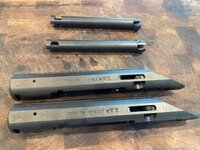
The H gun was probably made in Fall 2024 and has been abused and reconfigured a few times. The J gun is "new".
Also, I can't see a difference between the black action I had treated last time versus these 2 stainless actions.
The assembled gun was a factory black action.
The one laying on it was a stainless action.
You can't tell the difference in person.
The only difference at time of photo is that the assembled gun got wiped with olive oil 6 months ago when I put it together and the one laying on top is still raw and damp.
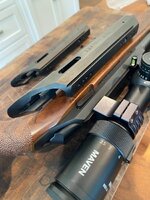

The H gun was probably made in Fall 2024 and has been abused and reconfigured a few times. The J gun is "new".
Also, I can't see a difference between the black action I had treated last time versus these 2 stainless actions.
The assembled gun was a factory black action.
The one laying on it was a stainless action.
You can't tell the difference in person.
The only difference at time of photo is that the assembled gun got wiped with olive oil 6 months ago when I put it together and the one laying on top is still raw and damp.

Yes.Are you removing the barrel before nitriding the bbl and action?
Similar threads
- Replies
- 65
- Views
- 3K
- Replies
- 11
- Views
- 2K
Featured Video
Latest Articles
- TT#64 Josh Boyd Elk Hunting Strategies for Every Season
- Aaron Davidson of Gunwerks
- TT#63 Dirk Durham’s Art of Elk Calling
- BIG Buck Stories with the Dirty Giants Podcast
- TT#62 Brian Barney Hunting Bulls without Calling
- Hoyt Alpha AX-2 SD Review
- Kuiu Kenai vs Outdoor Vitals Vario Hooded Jacket Review
- Hoyt RX-9 Ultra Review
- Hunting Vampire Bucks & Building an Optics Kit
- Darton Sequel ST2 35 Review

